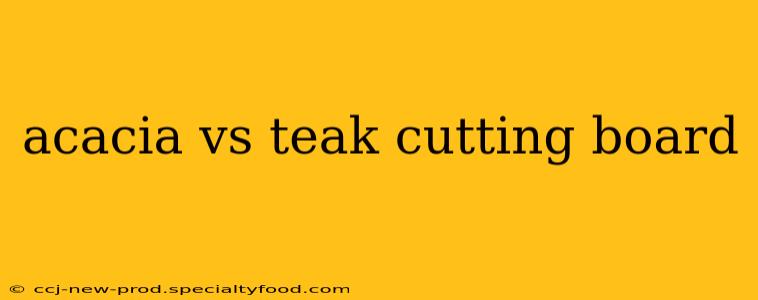Choosing the right cutting board can significantly impact your cooking experience and the longevity of your knives. Two popular choices often top the list: acacia and teak wood. Both are known for their durability and attractive grain, but they possess distinct characteristics that make them suitable for different needs and preferences. This comprehensive guide will delve into the key differences between acacia and teak cutting boards, helping you make an informed decision.
What are the Differences Between Acacia and Teak Wood Cutting Boards?
The core distinctions between acacia and teak lie in their density, hardness, water resistance, and overall maintenance requirements. Let's break down these crucial factors:
Hardness and Durability:
-
Acacia: Acacia wood is a relatively hard wood, scoring around 900 on the Janka hardness scale (a measure of wood density). This makes it resistant to scratches and dents, ideal for everyday use.
-
Teak: Teak boasts a Janka hardness score of around 1000, making it slightly harder than acacia. This translates to even greater resistance to wear and tear.
Water Resistance:
-
Acacia: Acacia wood possesses natural oils that provide some level of water resistance. However, prolonged exposure to moisture can still lead to warping or cracking. Regular oiling is recommended to maintain its integrity.
-
Teak: Teak is naturally highly water-resistant due to its high oil content. It can withstand more moisture than acacia, making it a more suitable choice for environments with higher humidity or frequent washing.
Appearance and Grain:
-
Acacia: Acacia features a rich, warm tone that ranges from light golden brown to dark reddish-brown, often with striking grain patterns.
-
Teak: Teak exhibits a beautiful, golden-brown hue that deepens with age, developing a silvery patina over time. Its grain is typically straighter than acacia's, giving it a more uniform appearance.
Maintenance and Care:
-
Acacia: Requires regular oiling (every few months or as needed) to prevent drying and cracking. Hand washing is recommended. Avoid prolonged soaking in water.
-
Teak: While generally more durable, teak also benefits from occasional oiling to enhance its water resistance and maintain its rich color. It's similarly best hand-washed and not submerged for extended periods.
Which Wood is Best for Cutting Boards?
The "best" wood depends entirely on your individual needs and priorities.
-
Choose Acacia if: You want a durable, attractive cutting board that’s relatively easy to maintain and offers a good balance of hardness and water resistance. Its varied grain patterns add a touch of rustic charm.
-
Choose Teak if: You prioritize exceptional water resistance and durability, even in humid conditions. Teak’s slightly harder nature makes it incredibly resistant to wear, and its elegant, consistent grain provides a sophisticated look.
How to Care for Your Wooden Cutting Board (Acacia or Teak)
Regardless of your choice, proper care is crucial for extending the life of your cutting board:
- Hand wash only: Avoid dishwashers, as the high heat and harsh detergents can damage the wood.
- Regular oiling: Apply a food-safe mineral oil or cutting board conditioner every few months (or as needed) to keep the wood hydrated and prevent cracking.
- Dry thoroughly: After washing, dry the board completely with a clean towel to prevent moisture buildup.
- Avoid prolonged soaking: Don't leave the board submerged in water.
What are the pros and cons of acacia and teak cutting boards?
Acacia Cutting Board Pros & Cons:
Pros: Relatively hard, visually appealing, readily available, usually more affordable than teak.
Cons: Less water-resistant than teak, requires more frequent oiling.
Teak Cutting Board Pros & Cons:
Pros: Highly water-resistant, exceptionally durable, naturally beautiful patina develops over time.
Cons: Generally more expensive than acacia, may require occasional sanding to remove surface imperfections.
Are there other types of wood suitable for cutting boards?
Yes, many other hardwoods are used for cutting boards, including maple, bamboo, and walnut. Each offers unique properties and aesthetics. Researching these options can help you find the perfect fit for your culinary style and budget.
This detailed comparison should help you determine whether an acacia or teak cutting board best suits your kitchen needs. Remember to always prioritize proper care and maintenance to maximize the lifespan and beauty of your chosen board.
